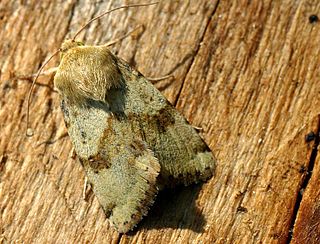
Heliothis viriplaca, the marbled clover, is a moth of the family Noctuoidea. It is found in Europe and across the Palearctic to Central Asia then to Japan, Korea and Sakhalin. In the south, it penetrates to Kashmir and Myanmar. As a migratory moth, it also reaches areas in northern Fennoscandia in some years. North of the Alps, both indigenous and immigrant individuals occur in certain areas. The heat-loving species occurs mainly on dry grasslands, fallow land, heathlands and sunny slopes and slopes and the edges of sand and gravel pits.

Amblyptilia epotis is a moth of the family Pterophoridae. It is endemic to New Zealand and is found in the South and Stewart Islands. It inhabits mountainous terrain covered in alpine vegetation or alternatively alpine wetland habitat. The adults of this species are on the wing from February to March. In appearance the adults of this species are variable in colour however this species can be distinguished from similar species by the oblique apical streak on its forewings as well as the patch of white on the costa cilia towards the apex of the forewing.
Ardozyga aeolopis is a species of moth in the family Gelechiidae. It was described by Edward Meyrick in 1904. It is found in Australia, where it has been recorded from New South Wales.
Gelechia sematica is a moth of the family Gelechiidae first described by Edward Meyrick in 1913. It is found in Namibia and South Africa.
Scrobipalpa chersophila is a moth in the family Gelechiidae. It was described by Edward Meyrick in 1909. It is found in South Africa.
Torodora fortis is a moth in the family Lecithoceridae. It was described by Edward Meyrick in 1918. It is found in southern India.
Deltoplastis straminicornis is a moth in the family Lecithoceridae. It was described by Edward Meyrick in 1910. It is found in Sri Lanka.
Deltoplastis balanitis is a moth in the family Lecithoceridae. It was described by Edward Meyrick in 1910. It is found in southern India.
Antaeotricha resiliens is a moth in the family Depressariidae. It was described by Edward Meyrick in 1925. It is found in Brazil.
Imma caelestis is a moth in the family Immidae. It was described by Edward Meyrick in 1906. It is found in western China.
Imma chasmatica is a moth in the family Immidae. It was described by Edward Meyrick in 1906. It is found in the Indian states of Sikkim and Assam.
Imma chlorosoma is a moth in the family Immidae. It was described by Edward Meyrick in 1906. It is found in Assam, India.
Imma cyclostoma is a moth in the family Immidae. It was described by Edward Meyrick in 1906. It is found in Assam in India and Tanintharyi Region of Myanmar.
Imma hyphantis is a moth in the family Immidae. It was described by Edward Meyrick in 1906. It is found in Sri Lanka.
Imma nephallactis is a moth in the family Immidae. It was described by Edward Meyrick in 1906. It is found in Venezuela.
Imma strepsizona is a moth in the family Immidae. It was described by Edward Meyrick in 1906. It is found on Sulawesi.
Imma thyriditis is a moth in the family Immidae. It was described by Edward Meyrick in 1906. It is found on the Solomon Islands.
Imma periploca is a moth in the family Immidae. It was described by Edward Meyrick in 1910. It is found on New Guinea.
Imma halonitis is a moth in the family Immidae. It was described by Edward Meyrick in 1920. It is found in Chennai, India.
Imma synconista is a moth in the family Immidae. It was described by Edward Meyrick in 1918. It is found in Kanara, India.

